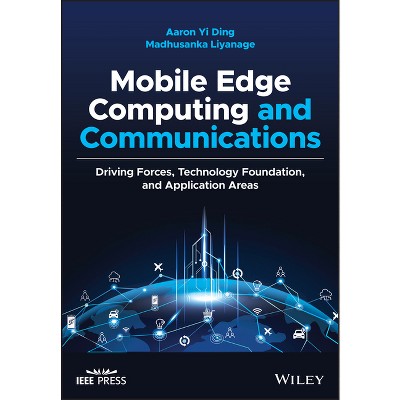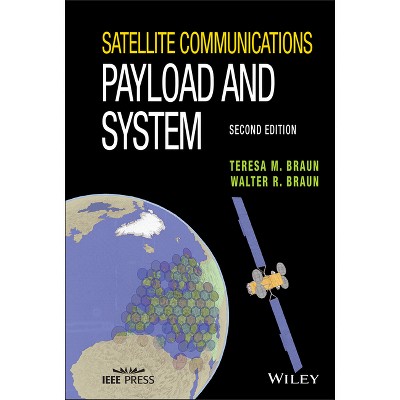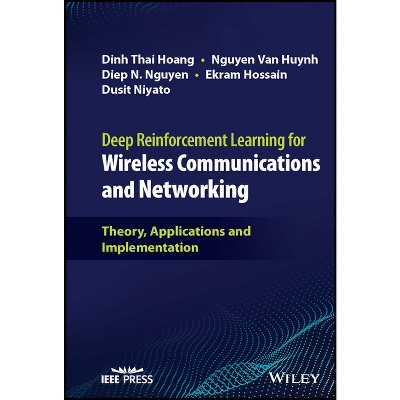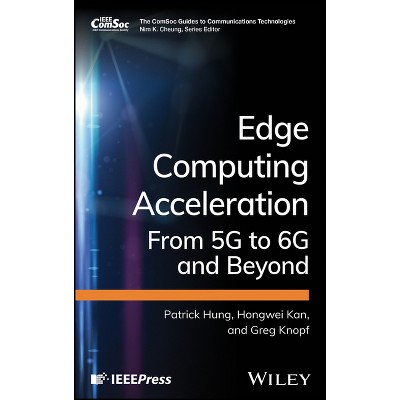Wireless Communications - (IEEE Press) 3rd Edition by Andreas F Molisch (Paperback)

About this item
Highlights
- An in-depth and comprehensive treatment of wireless communication technology ranging from the fundamentals to the newest research results The expanded and completely revised Third Edition of Wireless Communications delivers an essential text in wireless communication technology that combines mathematical descriptions with intuitive explanations of the physical facts that enable readers to acquire a deep understanding of the subject.
- About the Author: Andreas F. Molisch, PhD, is Professor and Golomb-Viterbi Chair at the University of Southern California, USA.
- 1008 Pages
- Technology, Mobile & Wireless Communications
- Series Name: IEEE Press
Description
About the Book
"Wireless communications is one of the most important modern technologies and is interwoven with all aspects of our daily lives. When we wake up, we check social media, email, and news on our smartphones. Before getting up, we adjust the room temperature through a Bluetooth-connected thermostat. After we leave the house and activate the Wi-Fi security cameras, we order a rideshare on a phone app that recognizes our location and are driven to a factory where manufacturing robots are connected and controlled via 5G. And that is only the start of the day.... It is thus no wonder that wireless infrastructure, user devices, and networks are among the largest and most critical industries in most countries. As the demands for wireless services constantly increase, so are the requirements for new products, and for engineers that can develop these products and bring them to market. Such engineers need a deep understanding of both the fundamentals that govern the behavior of wireless systems, the current standardized systems implementations, and more recent research developments that will influence the next generation of products. The goal of this book is to help students, researchers, and practicing engineers to acquire, refresh, or update this knowledge. It is designed to lead them from the fundamental principles and building blocks, such as digital modulation, fading, and reuse of spectrum, to more advanced technologies that underly modern wireless systems, such as multicarrier and multiantenna transmission, to a description of the standardized systems dominating 5G cellular, Wi-Fi, and short-range communications, to the cutting-edge research that will form the basis for beyond-5G systems. In brief, the book leads the reader from the fundamentals to beyond 5G"--Book Synopsis
An in-depth and comprehensive treatment of wireless communication technology ranging from the fundamentals to the newest research results
The expanded and completely revised Third Edition of Wireless Communications delivers an essential text in wireless communication technology that combines mathematical descriptions with intuitive explanations of the physical facts that enable readers to acquire a deep understanding of the subject.
This latest edition includes brand-new sections on cutting edge research topics such as massive MIMO, polar codes, heterogeneous networks, non-orthogonal multiple access, as well as 5G cellular standards, WiFi 6, and Bluetooth Low Energy. Together with the re-designed descriptions of fundamentals such as fading, OFDM, and multiple access, it provides a thorough treatment of all the technologies that underlie fifth-generation and beyond systems. A complementary companion website provides readers with a wealth of old and new material, including instructor resources available upon request.
Readers will also find:
- A thorough introduction to the applications and requirements of modern wireless services, including video streaming, virtual reality, and Internet of Things.
- Comprehensive explorations of wireless propagation mechanisms and channel models, ranging from Rayleigh fading to advanced models for MIMO communications.
- Detailed discussions of single-user communications fundamentals, including modern coding techniques, multi-carrier communications, and single-user MIMO.
- Extensive description of multi-user communications, including packet radio systems, CDMA, scheduling, admission control, cellular and ad-hoc network design, and multi-user MIMO.
- In-depth examinations of advanced topics in wireless communication, like speech and video coding, cognitive radio, NOMA, network coding, and wireless localization.
- A comprehensive description of the key wireless standards, including LTE, 5G, WiFi, Bluetooth, and an outlook to Beyond 5G systems.
Perfect for advanced undergraduate and graduate students with a basic knowledge of standard communications, Wireless Communications will also earn a place in the libraries of researchers and system designers seeking a one-stop resource on wireless communication technology.
From the Back Cover
An in-depth and comprehensive treatment of wireless communication technology ranging from the fundamentals to the newest research results
The expanded and completely revised Third Edition of Wireless Communications delivers an essential text in wireless communication technology that combines mathematical descriptions with intuitive explanations of the physical facts that enable readers to acquire a deep understanding of the subject.
This latest edition includes brand-new sections on cutting edge research topics such as massive MIMO, polar codes, heterogeneous networks, non-orthogonal multiple access, as well as 5G cellular standards, WiFi 6, and Bluetooth Low Energy. Together with the re-designed descriptions of fundamentals such as fading, OFDM, and multiple access, it provides a thorough treatment of all the technologies that underlie fifth-generation and beyond systems. A complimentary companion website provides readers with a wealth of old and new material, including instructor resources available upon request.
Readers will also find:
- A thorough introduction to the applications and requirements of modern wireless services, including video streaming, virtual reality, and Internet of Things.
- Comprehensive explorations of wireless propagation mechanisms and channel models, ranging from Rayleigh fading to advanced models for MIMO communications.
- Detailed discussions of single-user communications fundamentals, including modern coding techniques, multi-carrier communications, and single-user MIMO.
- Extensive description of multi-user communications, including packet radio systems, CDMA, scheduling, admission control, cellular and ad-hoc network design, and multi-user MIMO.
- In-depth examinations of advanced topics in wireless communication, like speech and video coding, cognitive radio, NOMA, network coding, and wireless localization.
- A comprehensive description of the key wireless standards, including LTE, 5G, WiFi, Bluetooth, and an outlook to Beyond 5G systems.
Perfect for advanced undergraduate and graduate students with a basic knowledge of standard communications, Wireless Communications will also earn a place in the libraries of researchers and system designers seeking a one-stop resource on wireless communication technology.
Review Quotes
"this text is an essential resource for anyone looking to deepen their knowledge or enter the field of wireless communications"
--Bo Rong, Rupendra Nath Mitra IEEE Wireless Communications June 2024
About the Author
Andreas F. Molisch, PhD, is Professor and Golomb-Viterbi Chair at the University of Southern California, USA. He has authored, co-authored, or edited 4 books, 21 book chapters, over 270 journal papers, and 70 patents. He is an IEEE Distinguished Lecturer, a Fellow of the National Academy of Inventors, Fellow of AAAS, IEEE, and IET, and Member of the Austrian Academy of Sciences.











